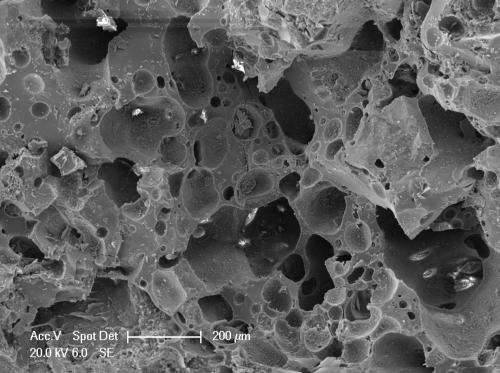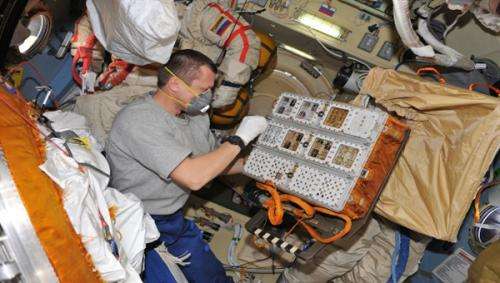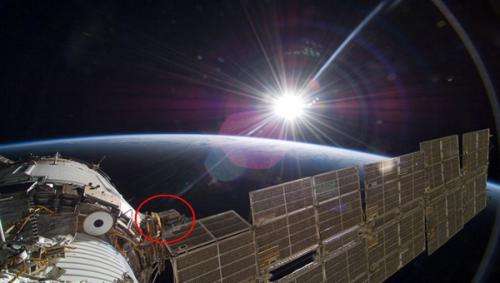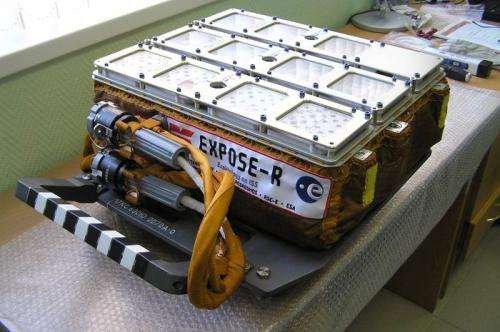Cosmic impacts may help create suitable habitat for life

Cosmic impacts are known to trigger mass extinctions on Earth. However, a new study adds to evidence that asteroid and cometary bombardment can also shelter life by generating pores in rocks that shelter microbes from damaging radiation.
These new findings, detailed in the International Journal of Astrobiology, could reveal good places for scientists to look for life on distant planets, the researchers added.
For the last 2.5 billion years, life on Earth has been protected from damaging ultraviolet radiation by the ozone layer. When ultraviolet rays split normal oxygen molecules (O2) apart, the oxygen atoms can recombine to form ozone (O3).
However, life on Earth has existed for at least 3.5 billion years—a full billion years before there was enough oxygen in the atmosphere to create an ozone layer. Oxygen built up in the Earth's atmosphere with the evolution of oxygen-emitting microbes. The early absence of an ozone layer means that life prior to the rise in oxygen would receive a dose of ultraviolet radiation a thousand times more damaging to DNA than today.
Scientists conjectured there were a number of ways that early life might have survived the intense levels of ultraviolet radiation they experienced. One strategy would have involved microbes forming thick, multi-layered mats known as stromatolites. Although the top layers of microbes in these mats might get killed off by ultraviolet light, they would protect lower layer.
Another way to survive ultraviolet radiation might be to grow within or under rocks that can serve as shields. One kind of stone that microbes might seek refuge in are crystalline rocks that are altered or "shocked" by the intense heat and pressures of cosmic impacts. Researchers think that roughly 3.8 billion years to 4.2 billion years ago, hordes of asteroids and comets pummeled Earth, the Moon and the inner planets during an era known as the Late Heavy Bombardment. It was a violent period of time that overlaps with the oldest evidence of life on Earth.
A great deal of prior studies suggest impact craters may be good shelters "for life on the early Earth and elsewhere in the Solar System," said lead study author Casey Bryce, a geo-microbiologist at the United Kingdom Center for Astrobiology at the University of Edinburgh in Scotland.
"Although we usually think of impacts as destructive events, which they clearly are, they can also change the geology in a way which makes it more favorable for microbial life than the original habitat," Bryce said.
Senior study author Charles Cockell, a geo-microbiologist and director of the United Kingdom Center for Astrobiology, and his colleagues investigated a kind of crystalline rock known as gneiss that was taken from Haughton Impact Crater in the Canadian High Arctic. The crater is about 39 million years old, and is roughly 10 miles (16 kilometers) wide.
"It's really cold there and there is really high ultraviolet radiation, especially in the summer with constant daylight," Bryce said. "It looks completely barren at first, but they cracked open the rocks and started to find these green bands of photosynthetic bacteria living just under the surface, particularly in the really highly shocked rocks most affected by the meteorite impact."
The scientists conjectured the bacteria grew in the impact-shocked rocks to escape damage from the high levels of ultraviolet radiation in the Arctic. Impacts can make gneiss 25 times more porous, increasing the amount of light that can permeate through so that bacteria could still photosynthesize below the surface.

"Without the impact, that habitat wouldn't have been available," Bryce said.
Cockell and his colleagues previously calculated that microbes living at depths of just 0.07 inches (2 millimeters) within porous impact-shocked gneiss and under the harsh ultraviolet light of the early Earth would experience at most one-tenth of the DNA damage they would on the surface of the Earth today. At the same time, they would receive enough light for photosynthesis.
In addition to providing a shield against ultraviolet rays, the pores of these impact-shocked rocks can allow hot water to circulate within the rocks as well. This hot water "can provide heat in a cold environment and pick up elements from the rocks to provide nutrients and energy sources," Bryce said.
The exposed land on the early Earth would most likely have been predominantly composed of crystalline rocks. This fact, together with all the impacts Earth experienced during the Late Heavy Bombardment, suggested that impact-shocked rock would have been widespread, providing habitats in which the first microbes could survive under the harsh ultraviolet light encountered on Earth's land masses.
However, Cockell and his colleagues only tested how well rock would protect microbes from ultraviolet radiation for only short periods of time, and only using levels of ultraviolet light seen on Earth in the present-day. In the most recent study, the researchers tested how well impact-shocked gneiss defends organisms for nearly two years from the level of ultraviolet rays present at the time of early Earth.
For these new experiments, Bryce, Cockell and their colleagues went to the International Space Station, which orbits the Earth at an altitude of about 280 miles (450 kilometers).
"Because the International Space Station orbits above the ozone shield, it allows us to simulate a worst-case early Earth ultraviolet environment for a long period of time," Bryce said.
The scientists experimented with photosynthetic bacteria known as Chroococcidiopsis. In the most extreme hot, cold, arid and salty habitats on Earth, these microbes are generally the dominant photosynthetic bacteria, typically living within rocks.
The investigators used these cells to coat 12 disks of impact-shocked gneiss about 0.4 inches (1 centimeter) in diameter and about 0.2 inches (5 millimeters) thick. The pores in these rocks are about 10 to 200 microns wide—in the range of the average width of a human hair at 100 microns.
The rock was collected from the center of Haughton Impact Crater, where the impact was most intense.

"It is quite crumbly, which can be difficult to work with," Bryce said.
These disks were exposed to ultraviolet radiation for 22 months at the International Space Station in the European Space Agency's EXPOSE-R facility, which can expose samples to a wide variety of extreme conditions.
"The cells grow really slowly, and it takes a few months to see whether there is going to be any growth or not, so that was quite an exciting wait," Bryce said.
Within four weeks, numerous green specks were seen on the rock disks. After two months, growth was clearly seen in all experimental samples. In contrast, no growth was seen on 36 glass disks the researchers coated with the bacteria. Instead, the DNA was broken and pigments essential for photosynthesis were destroyed on the glass disks even when the microbes received just 0.01 percent of the amount of ultraviolet light seen on the early Earth.
These new findings suggest impact craters may be a good place to look for life on worlds that receive high levels of ultraviolet light.

"Impacts are so common in the Universe, and this is another piece of evidence that they could be universally important habitats," Bryce said.
While these experiments took place under ultraviolet light levels comparable to those found on the early Earth, "these experiments are performed in a vacuum and not under an early Earth-like atmosphere," Bryce cautioned.
Future research will seek to understand how the presence of an atmosphere could affect the survival of microbes under high ultraviolet light, she said.
More information: Bryce et al. (2014) 'Impact shocked rocks as protective habitats on an anoxic early Earth,' International Journal of Astrobiology, DOI: dx.doi.org/10.1017/S1473550414000123
Journal information: International Journal of Astrobiology
Provided by Astrobio.net





















